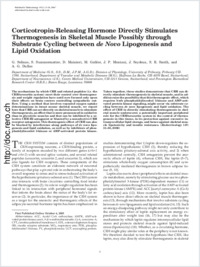Corticotropin-Releasing Hormone directly stimulates thermogenesis in skeletal muscle possibly through substrate cycling between de novo lipogenesis and lipid oxidation
- Solinas, Giovanni Department of Medicine, Division of Physiology, University of Fribourg, Switzerland
- Summermatter, Serge Department of Medicine, Division of Physiology, University of Fribourg, Switzerland
- Mainieri, Davide Department of Medicine, Division of Physiology, University of Fribourg, Switzerland
- Gubler, Marcel Department of Vascular and Metabolic Diseases, Hoffman-La Roche, Basel, Switzerland
- Montani, Jean-Pierre Department of Medicine, Division of Physiology, University of Fribourg, Switzerland
- Seydoux, Josiane Department of Neuroscience, Centre Médical Universitaire, Geneva, Switzerland
- Smith, S. R. Pennington Biomedical Research Center, Baton Rouge, Louisiana, USA
- Dulloo, Abdul G. Department of Medicine, Division of Physiology, University of Fribourg, Switzerland
-
2006
Published in:
- Endocrinology. - 2006, vol. 147(1), p. 31-38
English
The mechanisms by which CRH and related peptides (i.e. the CRH/urocortin system) exert their control over thermogenesis and weight regulation have until now focused only upon their effects on brain centers controlling sympathetic outflow. Using a method that involves repeated oxygen uptake determinations in intact mouse skeletal muscle, we report here that CRH can act directly on skeletal muscle to stimulate thermogenesis, an effect that is more pronounced in oxidative than in glycolytic muscles and that can be inhibited by a selective CRH-R2 antagonist or blunted by a nonselective CRH receptor antagonist. This thermogenic effect of CRH can also be blocked by interference along pathways of de novo lipogenesis and lipid oxidation, as well as by inhibitors of phosphatidylinositol 3-kinase or AMP-activated protein kinase. Taken together, these studies demonstrate that CRH can directly stimulate thermogenesis in skeletal muscle, and in addition raise the possibility that this thermogenic effect, which requires both phosphatidylinositol 3-kinase and AMP-activated protein kinase signaling, might occur via substrate cycling between de novo lipogenesis and lipid oxidation. The effect of CRH in directly stimulating thermogenesis in skeletal muscle underscores a potentially important peripheral role for the CRH/urocortin system in the control of thermogenesis in this tissue, in its protection against excessive intramyocellular lipid storage, and hence against skeletal muscle lipotoxicity and insulin resistance.
- Faculty
- Faculté des sciences et de médecine
- Department
- Département de Médecine
- Language
-
- English
- Classification
- Medicine
- License
-
License undefined
- Identifiers
-
- RERO DOC 5827
- DOI 10.1210/en.2005-1033
- Persistent URL
- https://folia.unifr.ch/unifr/documents/300042
Statistics
Document views: 149
File downloads:
- Texte intégral: 168
